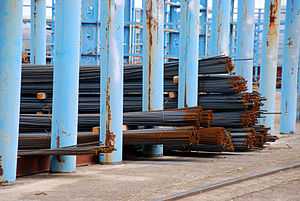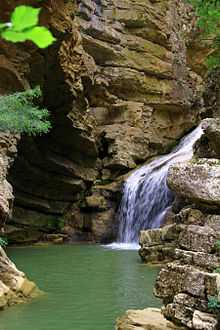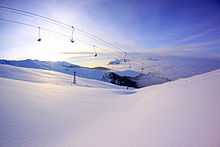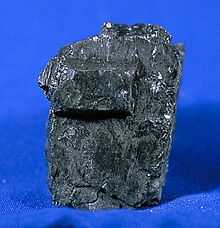Industry of Kosovo
| Industrial production | ||
|---|---|---|
| | ||
| The Trepca Mine | ||
| Main industries | Mining, cement and construction, textiles, food and beverages, tourism, metallurgical industry. | |
| Industrial growth rate | NA% | |
| Labor force | 800,000 (2011). Country comparison to the world: 150 | |
| GDP of sector | 22.6% of total GDP | |
Kosovo has a slowly developing plain industry. In 2009, the Industry accounted for 22.60 of GDP and a general workforce of 800,000 employees. It's on 150 th place, compared to the rest of the world.[1] There are numerous reasons for this kind of stagnation, ranging from consecutive occupations, political turmoil and the recent Kosovo War (1999).[2]
Overview
Kosovo has several industry sectors, as the most developed ones are: Ferrous and Non-Ferrous, Metallurgy and Mining. In northern Kosovo, near the town of Mitrovica, sits a huge dilapidated industrial site known as the Trepca mining complex. During the 1980s, it employed 20,000 workers and accounted for 70 percent of all Yugoslavia's mineral wealth. One economist described Trepca as a "colossal conglomerate composed of more than forty mines, foundries, and subsidiary plants – which [at its height] generated 25 percent of the entire regional industrial production and figured among the principal exporters of the ex-Yugoslavia.' According to the same study, 'In the subsoil of Kosovo, one of the richest of Europe, enormous deposits are hidden of lignite, lead, zinc, non-ferric metals, gold, silver and petroleum," on top of 17 billion tons of coal.[3]
Other developed industry sectors in Kosovo are Energy, Textile and Food Industries, Tourism, etc.
Kosovo Energy Corporation J.S.C (KEK) is the sole power corporation in the Republic of Kosovo. KEK is vertically integrated and was legally incorporated in 2005. KEK was part of the Yugoslavia power system, and focused in production of energy from coal, with power supplied from plants outside of Kosovo. By the late 1990s, the core business of the Corporation became the production of coal and energy in Kosovo, through two open-cast coal mines - the Mirash mine and Bardh mine[4] - and two power plants, PP Kosova A power station and PP Kosova B power station, which cover the territory of Kosovo. There are approximately 400,000 customers and 8,000 employees in different sectors.[5]
There was no privatization of other sectors; hence most of them are dysfunctional.[3]
History of Industry
Before Kosovo War (1999)
In 1455, Novobërdë was completely destroyed by Turks who occupied it, when about 40.000 inhabitants were sent to Asia, as slaves. [6]
The Englishmen bought concession in 1926, and the enterprise 'Trepca Mines Limited' existed under this name from 1927 until the end of the Second World War.[7]
In 50s, the Kosovo's Industry structure was poor. Non-Ferrous Metallurgy made the most effort and gave the most value to production and employed almost the half of employees in the Mining Industry. Construction materials made one eighth of it, as much as the coal, and half of it Tobacco, Wood and Textile industry.[2]
The Industries which generated the most of the revenues in 1987 were: electricity, production of machinery, ferrous metallurgy, textile, electrical appliances, metal works, food processing industry, footwear and wood Industry through 1980 reached considerable development level but in 90s it had stagnation in the development, manufacturing, employment and export. This stage and the war contributed to nearly complete collapse of Kosovo Industry.[2]
Other production: In the period from 1965-1985, several factories for processing of metals were built, such as:
- Production of lead accumulators in Mitrovica and Peja,
- Processing of gold and silver in Prizren,
- Factory of zinc coated sheet in Vucitrn,
- Factory for production of nickel-cadmium batteries in Gjilan.[8]
After Kosovo War (1999)
Kosovo was in very serious economic and social situation, i.e. it was in state of emergency. There was an immediate need for shelters, food, housing and refurbishment of houses and apartments. After the emergency phase, the commercialization process started in factories which failed to resume production in many factories (except few).[3]
The privatization process started in 2003, but there were delays and it failed to function properly for many reasons.[3]
Mineral resources
Kosovo territory possesses reserves significant lignite coal type that is believed to be around 14 billion tones, small quantities of nuclear matter, resources geothermal energy level low and natural gas potential area. Kosovo has mineral resources deposits with the European level, it mainly has large reserves of silver, zinc, coal, lead, zinc, copper, iron, nickel and bauxite. That meets classification standards international trade (UNFC, JORC).[9] In 2005 the Directorate for Mines and Minerals and the World Bank estimated that Kosovo had €13.5 Billion worth of minerals.[10] However, Kosovo has a high density of population and buildings by South-Eastern European standards, and full exploitation of these resources at an acceptable environmental cost may not be easy.[9]
Coal
Coal (lignite) is the most important energy resource of Kosovo, which supplies about 97% of total electricity production. Estimated coal resources in throughout Kosovo are 12.5 billion tons, 8.6 billion tons of reserves are that economically exploitable considered profitable. The wealth of the mine in Sibofc [Sibovac] is estimated at 6.5 billion euros, wealth of Trepca at 3 billion, wealth of Ferronickel 2 billion, whereas the wealth of the resources in other parts of Kosovo were estimated at 2 billion euros.
At 14,700 Mt, Kosovo possesses the world's fifth-largest proven reserves of lignite. The lignite is distributed across the Kosovo, Dukagjin and Drenica Basins, although mining has so far been restricted to the Kosovo Basin. The first systematic records of lignite exploitation date from 1922, when small-scale, shallow underground room-and-pillar mining commenced in the Kosovo Basin. Large-scale winning of lignite began with the first production from the Mirash (1958) and Bardh (1969) open-pit mines, using bucket wheel excavators.[11]
Bauxite
Bauxite carrying region is part of the massif of ultra basic rocks Orahovac. The origin and appearances stretching the bauxite Gremnikut Mountain, 5 to 10 km (6 mi) southeast of Kline. Bauxite Kosovo belongs to the group of Ferro-bauxite due to extreme content high iron. Dynamics of bauxite reserves are about 2.7 Mt and reserves Limestone reach accompanying figure of about 40 Mt17. The mine began operations in 1966. 1990 wide since 1966,3255615 t bauxite were used. The largest annual production passed 200,000 tons/year.[12]
Quartz
Industrial mineral quartz as high quality found in eastern Kosovo, central and south. Appearances and most popular fields found in: Strezoc, south of Binçës Bukovikut west and Debelde. Reserves of quartz in Strezoci are estimated to be in the area and Mt 2.53. Binça,3.1 Mt and Bukovikut (southeast of Kosovo) contains about 19 Mm ³.[13]
Gold
In the Republic of Kosovo presented in paragjenezë gold with copper ore, lead and pure zinc (born) in the river alluvial deposits. Now extensive gold and silver are extracted only from the lead-zinc ores. Gold mineralization is associated with deposits of lead and zinc. In Mine Novo Brdo gold content is higher and this mine is known as the gas field higher composition of gold in Kosovo. Resources gold mine Artana estimated to be 2700 kg. According fields, evaluated the content of gold: Stanterg: 0.6 g/t, Bellobërdë: 0.7 g/t, Cernac: 1.0 g/t, Hajvali: 0.5 g / t, Kizhnica: 1.1 g/t, Badoc: 12:25 g/t, Artanë: 1.6 g/t, Crepulë: 12:13 g/t18. [14]
Magnesite
Kosovo possesses two magnesite (MgCO3) mines at Golesh and Strezovc. Both were originally worked as quarries and both moved to underground operations prior to their closure in 1999. Before 1990, the Golesh operation produced 110,000 t of magnesite, 22,000 t of sintered magnesia and 10,000 t of caustic calcite magnesia per annum. Golesh mine is accessed via a shaft, where as Strezovc is accessed via a horizontal add it in the hillside. .[15]
Nickel
Former open-pit mining operations based on late rite were undertaken at Çikatova (Dushkaja and Suke) and Gllavica. Remaining mine able reserves have been calculated as 13.2 Mt averaging 1.42% Nickel and 0.05% Co. Production stopped in 1999 and has yet to resume. The socially owned enterprise (SOE) 'Ferronikeli' mining complex has been put to international competitive tender for privatization.[15]
Chrome
A chain of Alpine-type chromes pods in southwestern Kosovo are part of a series of linear deposits that continue into Albania. These pods are small but of high grade and in Albania are known to possess enhanced levels of platinum group metals (PGM). From the end of World War Two until 1956, the ores were worked, primarily from the Gjakova mine by Deva holding company, and direct-shipping ore was sent to Albania for treatment. When the high-grade ore was depleted, Kosovo began importing 30,000- 50,000 t/y of chromites ore from Albania. This ceased when the plant was closed in 1991. No meaningful exploration for chrome has been undertaken for several decades.[15]
Sectors
Trepca Mine
| Metal | 1946 | 1956 | 1975 | 1988 | 1995 | 2001 |
|---|---|---|---|---|---|---|
| Lead (t) | 23.007 | 63.216 | 89.138 | 83.445 | 12.186 | 700 |
| Silver (kg) | 7.317 | 83.145 | 111.396 | 95.491 | 19.051 | 5.700 |
| Bismuth (kg) | 17.141 | 111.150 | 55.243 | 22.272 | 0 | 0 |
| Zinc (t) | 0 | 0 | 28.808 | 48.550 | 5.118 | 0 |
| Cadmium (kg) | 0 | 0 | 73.200 | 156.400 | 11.000 | 0 |
The Trepca mining complex in Kosovo is a huge dilapidated industrial site near Mitrovice. For the first time in literature the name Trepca was specified in 1303 in some documents in archive of Dubrovnik.The first geological research started in 1924.[16] The British, who built the plant in 1927 and supposedly secured a 50-year concession, terminated in 1941, are demanding compensation.[17] In 1930, starts trial production of sulphur mineralization Pb - Zn in this source. During World War II the Germans hold Trepca mine in working condition, but with a reduced level of production. From 1945 until 1990, the mine has been working non-stop, with an average production capacity of about 600,000 tons per year.[16]
However, after the war, during the period 2000 - 2004, the mine has not produced, but has been researching and preparing for production workshops. So in 2005 the mine began producing Pb and Zn with minimum capacity. The greatest success achieved by Trepca combine in 1983 was when Trepca exported goods worth of 103 million dollars, ranking the fifth in its own exporters in the former Yugoslavia. For 58 years of productive work, combine Trepca has produced 33 million tons of ore containing average 9% (Pb and Zn), or about 3 million tons of metal (Pb and Zn).[16]

Trepca complex has 14.700 million tons of lignite reserves used for energy production in Kosovo, making Kosovo the fifth country in the world for lignite reserves. This mining complex comprises about 40 mines.[18]
Mineral list contains entries from the region specified including sub-localities:
|
|
|
|
|
The Energy Industry
.jpg)
Kosovo Energy Corporation J.S.C (KEK) is the sole power corporation in the Republic of Kosovo. KEK is vertically integrated and was legally incorporated in 2005. KEK was part of the Yugoslavia power system, and focused in production of energy from coal, with power supplied from plants outside of Kosovo. By the late 1990s, the core business of the Corporation became the production of coal and energy in Kosovo, through two open-cast coal mines - the Mirash mine and Bardh mine[4] - and two power plants, PP Kosova A power station (880 MW, 40 year old) in poor condition and is the worst single-point source of pollution in Europe that was proposed to be shut down and PP Kosova B power station (700 MW, 27 year old) needs rehabilitation to meet EU environmental standards, which cover the territory of Kosovo. 98% of electricity generation in Kosovo comes from these two old, inefficient and highly polluting lignite-fired power plants.[20] There are approximately 1,900,000 customers and 60,000 employees in different sectors.[4]
| Kosovo lignite reserves compared to the rest of the World (in billion tonnes) |

|
Automotive components industry
Shock Absorber Factory Prishtina and Ramiz Sadiku are the two best known flagships of automotive component industrialization in Kosovo, which produced primarily car seats and small vehicle parts, which produced shock absorbers for various well-known brands such as British Armstrong, German Susta as well as French Peugeot among others. Between 1989 and 1990 the Shock Absorber Factory employed over 1,500 workers and produced 3.3 million units each year.[22]
Ferrous Industry

First industrial object was build in Peja (1968), 8,400 workers worked in this Industry (1987). In Prizren, Factory 'Famipa'- accessories for kitchen and sanitary fittings of gold and silver. In Gjakovë 'Metaliku', 'Metalac' in Janjevë, 'Vinex' in Viti and reinforcement steel factory in Podujevë. This industry produced metal packaging, stoves, and tin and steel constructions, aluminum utensils, etc.[23]
Non-ferrous Industry
Given that Kosovo was rich in non-ferrous metals (magnesium, marl, cement, kaolin for tiles, clay, quartz, gravel, etc.)j. The quicklime and slaked lime were produced in Kaçanik and the cement was produced in Elez Han (240,000 tons per year). The bricks and tiles were produced in Pristina, Podujeve, Skenderaj, Pejë and Gjakova, and this Industry employed more than 12,000 workers (2014).[23]
Paper Industry
Wood and paper industry were placed in some centres, where they produced planks, panel boards and plywood, parquet, doors, windows, chairs, tables, various furniture, paper, wrapping papers. City of Pejë, as an area rich in forests has prompted the development of this industry and had the most famous Factory 'Wood Combine and Furniture Factory'. In Deçan (parquet factory); 'Radusha' (doors and windows factory) in Istog; Wallpaper and Furniture Factory in Prishinë; 'Javor' – wood processing factory in Podujevë; paper and paperboard mill in Lipjan. This industry employed more than 8,000 workers.[24]
Textile
| JATEX | Gjakova |
| Unikat | Prishtina |
| REMATEKS | Dragash |
| Semtex | Gjakova |
| KosovaTex | Prishtina |
| Land Holding | Ferizaj |
With over 200 years of tradition, textiles were the second largest industrial sector in Kosovo, after mining. In the past, products from Kosovar manufacturers targeted the local market, as well as other markets throughout the former Yugoslavia, Western and Eastern Europe and the United States. At its peak around 1990, each of the 15 SOEs engaged in textile production employed more than 1,000 people and sales totaled some 600 million Euro.[26]

The most renowned centres of this industry were 'Kosovka'in Prishitnë; 'Polet' in Vushtrri; 'Printex' and 'Sintelon' in Prizren; 'Emin Duraku' and 'Konfeksion' in Gjakovë; 'Integji' and 'Taftingi' in Gjilan. Production line consisted of, but not limited to: cotton, wool, synthetic fabrics, knitwear, apparel clothing, curtains, carpets, etc. Textile sector employed more than 14,000 workers and most of its products were exported abroad.[23]
Recent developments in the region have frozen the primary trading links of the textile industry, causing lower production rates and resulting in a lack of competitiveness with foreign products. As a result, a major share of former SOE workers has become redundant. A minor part has, however, established private textile companies. Currently there are some 451 private companies engaged in textile production, out of which 90 percent are final product manufacturers. Although the textile industry has experienced a significant recovery during the past years, the majority of businesses are still small and take the form of micro enterprises. Consequently, they cater solely for the Kosovo market and are primarily geared towards a niche market.[26]
Wine Industry
Grape-growing and wine culture has a long tradition in Kosovo. While local small-scale wine – production was introduced rampantly during the last twenty years, the wine industry in Kosovo became large-scale in the 1970s with the founding of the first larger SOEs. During its "glory days", the wine industry benefited from 9,000 ha vineyard area, divided into private and public ownership, and spread mainly throughout the south and west of Kosovo. The four state-owned wine production facilities were not as much "wineries" as they were "wine factories". Only the Rahovec facility that held app. 36 percent of the total vineyard area had the capacity of around 50 million liters annually. The major share of the wine production was intended for exports. At its peak in 1989, the exports from the Rahovec facility amounted to 40 million litres and were mainly distributed to the German market.[27]
| Enterprise | Processing capacities in million litres |
|---|---|
| NBI "Rahoveci" - Rahovec | 50 |
| NBI Suhareka - Theranda | 21 |
| NBI Ereniku - Gjakova | 28 |
| Kosova Vine | 13 |
| Total | 112 |
The climate and the height of 300–400 meters above the sea level are incredibly well-suited for development of wine grapes and vineyards. There are more than 200 sunny days annually to help ripen the grapes, on par with some well known wine production regions. These advantages create very good conditions for the qualitative wine production in Kosovo. The wine industry in Kosovo currently consists of some 5,000 ha of vineyards, the Government of Kosovo has passed a Wine Law that governs wine production at a high standard and is perhaps one of the finest in the world for such a small growing region such as Kosovo.[27]
Production of Raki
Country's dispersed grape-growers and mass-oriented producers are well-suited for the Raki production (distilled grape brandy ) While uneven viticulture techniques among small grape-growers can impact the quality of wines, the distillation process that creates Raki can mask variations in quality of the grapes and still create a product that is potent and drinkable.[28]
Tourism

The natural values of Kosovo represent quality tourism resources. The description of Country's potential in tourism is closely related to the geographic position of Kosovo. Its position in south-eastern Europe, with a central position in the Balkan Peninsula, represents a crossroad which historically dates back to Illyrian and Roman times. The mountainous south of Kosovo has great potential for winter tourism. Skiing, one of the most interesting opportunities for foreign investors in this region is the skiing resort Brezovica in the SharrMountains. It offers perfect weather and snow conditions for ski seasons from November to May.[29]

Brezovica also includes three hotels with 680 rooms, two Restaurants and nine ski lifts with transport capacity of 10,000 skiers per hour. With close proximity to Prishtina Airport (60 km) and Skopje Airport (70 km), the resort is a possible destination for international tourists and has the potential to become the most desired winter tourism destination in the Balkans.
Also in the Sharr Mountains in the very south of the country, bordering Macedonia and Albania, Kosovo is offering for privatization about 22,000 hectares of largely untouched land in the mountainous area, belonging to the socially owned enterprise "Sharrprodhimi". The region offers excellent tourism opportunities, such as skiing, eco-tourism, paragliding, mountain biking, rock climbing, trekking, kayaking, horse riding, etc. The Sharrprodhimi land in the municipality of Dragash is stunningly beautiful. It is clearly a remarkable property for eco-tourism, and will only be sold to a proven investor who is committed to a sustainable and rational development program which will have strong local support.Apart from the above-mentioned tourism resorts, Kosovo is generally rich with mountains, artificial lakes and rivers and therefore also offers prime possibilities for hunting and fishing.[29]
See also
References
- ↑ "Kosovo International Rankings of Kosovo - 2013".
- ↑ 2.0 2.1 2.2 Asllan, Pushka. "Gjeografia 12". Libri Shkollor (2005). p. 77.
- ↑ 3.0 3.1 3.2 3.3 Asllan, Pushka. "Gjeografia 12". Libri Shkollor (2005). p. 78.
- ↑ 4.0 4.1 4.2 "Opportunities to Foreign Investment in Kosovo" (PDF). p. 46. Retrieved 27 February 2014.
- ↑ Asllan, Pushka. "Gjeografia 12". Libri Shkollor (2005). p. 79.
- ↑ "Historical review and actual situation of Metallurgy at Kosovo" (PDF). p. 2. Retrieved 26 February 2014.
- ↑ "Historical review and actual situation of Metallurgy at Kosovo" (PDF). p. 3. Retrieved 26 February 2014.
- ↑ 8.0 8.1 "Historical review and actual situation of Metallurgy at Kosovo" (PDF). p. 4. Retrieved 26 February 2014.
- ↑ 9.0 9.1 "Strategjia Minerare e Republikës së Kosovës për periudhën 2012-2025" (PDF). p. 7. Retrieved 27 February 2014.
- ↑ "KosovaReport".
- ↑ "Strategjia Minerare e Republikës së Kosovës për periudhën 2012-2025" (PDF). p. 12. Retrieved 27 February 2014.
- ↑ "Strategjia Minerare e Republikës së Kosovës për periudhën 2012-2025" (PDF). p. 20. Retrieved 27 February 2014.
- ↑ "Strategjia Minerare e Republikës së Kosovës për periudhën 2012-2025" (PDF). p. 24. Retrieved 27 February 2014.
- ↑ "Strategjia Minerare e Republikës së Kosovës për periudhën 2012-2025" (PDF). p. 22. Retrieved 27 February 2014.
- ↑ 15.0 15.1 15.2 "Kosovo-mining, Mineral deposits.".
- ↑ 16.0 16.1 16.2 "Trepca - Historiku".
- ↑ "The Trepca mining complex".
- ↑ "TREPCA - Making Sense of the Labyrint" (PDF). p. 3. Retrieved 27 February 2014.
- ↑ "Trepca Minerals".
- ↑ "World Bank Group Support to Kosovo's Energy Sector" (PDF). p. 6. Retrieved 27 February 2014.
- ↑ "Investing in Kosovo 2011" (PDF). p. 13. Retrieved 27 February 2014.
- ↑ "Investing in Kosovo" (PDF). p. 13. Retrieved 27 February 2014.
- ↑ 23.0 23.1 23.2 Asllan, Pushka. "Gjeografia 12". Libri Shkollor (2005). p. 81.
- ↑ Asllan, Pushka. "Gjeografia 12". Libri Shkollor (2005). p. 83.
- ↑ "IPAK - Investment Promotion Agency of Kosovo".
- ↑ 26.0 26.1 "Investing in Kosovo" (PDF). p. 14. Retrieved 25 February 2014.
- ↑ 27.0 27.1 "Investing in Kosovo - Vineyards".
- ↑ "The state of the Wine industry in Kosovo" (PDF). p. 17. Retrieved 26 February 2014.
- ↑ 29.0 29.1 "Investing in Kosovo" (PDF). p. 15. Retrieved 27 February 2014.
External links
- http://www.theodora.com/wfbcurrent/kosovo/kosovo_international_rankings_2013.html
- https://ritdml.rit.edu/bitstream/handle/1850/14112/Sytrime_Dervisholli_CapstoneProject_Report_8-31-2011.pdf
- http://www.invest-ks.org/repository/docs/Top10IPAK2012_758339.pdf
- http://www.eciks.org/english/publications/InvestinginKosovo_2011_Web.pdf
- http://www.invest-ks.org/repository/docs/factsheet-press_585369.pdf
- http://www.invest-ks.org/repository/docs/Kosovo_Presentation_on_Energy_Potentials_-_World_Bank_708477.pdf
- http://www.eciks.org/english/publications/investing_in_kosovo/content/iguide_3.html

